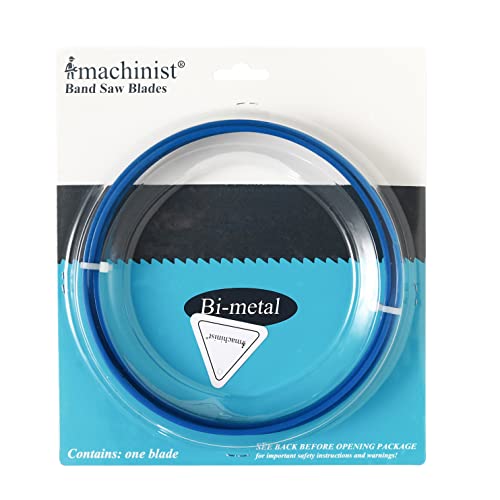Ever watched a bandsaw slice through metal like butter? It’s pretty amazing, right? But have you ever tried it yourself and ended up with a blade that’s dull or breaks quickly? Choosing the right bandsaw blade for metal can be tricky. There are so many different types, sizes, and tooth configurations. It’s like trying to pick the perfect ice cream flavor when you have no idea what you’re in the mood for.
Choosing the wrong blade can lead to frustrating results. It can cause slow cuts, rough edges, and a lot of wasted time and money. Understanding the different types of blades is crucial. This knowledge helps you avoid these common pain points and get the job done right.
In this blog post, we’ll break down everything you need to know about bandsaw blades for metal. We’ll cover the different blade materials, tooth pitches, and applications. You’ll learn how to select the perfect blade for your specific project. Get ready to say goodbye to frustrating metal cutting! Let’s dive in and find the right bandsaw blade for you!
Our Top 5 Bandsaw Blades For Metal Recommendations at a Glance
Top 5 Bandsaw Blades For Metal Detailed Reviews
1. Imachinist S933414 M42 93″ X 3/4″ X 10/14tpi Bi-Metal Metal Cutting Band Saw Blades
Rating: 9.4/10
The Imachinist S933414 M42 band saw blades are built for cutting metal. These bi-metal blades are strong and made with M42 grade steel. They are 93 inches long, 3/4 inch wide, and 0.035 inches thick. The teeth have a 10-14 TPI (teeth per inch) design. This blade is great for cutting soft ferrous metals, like steel. It is also good for cutting pipes and tubes.
What We Like:
- The blade is bi-metal, making it strong and long-lasting.
- M42 grade steel means the blade is tough.
- The 10/14 TPI is good for cutting thin materials and different shapes.
- It fits many band saws, including 7 x 12 models.
- The variable teeth size is useful for different cutting needs.
What Could Be Improved:
- The description could be more clear about what types of metal it cuts.
This band saw blade is a solid choice for metal cutting. If you need to cut metal, this blade is a good option to consider.
2. BOSCH BS6412-24M 64-1/2 In. 24 TPI Metal Cutting Stationary Band Saw Blade Ideal for Applications in Metal
Rating: 9.4/10
The BOSCH BS6412-24M band saw blade is built for cutting metal. It is a stationary band saw blade. This blade is 64-1/2 inches long and has 24 teeth per inch (TPI). It is designed for many metal cutting jobs. This blade helps you cut metal smoothly and accurately.
What We Like:
- The blade is great for metal.
- It is made with good materials. These materials stop heat from building up. This helps the blade last longer.
- The blade’s teeth are designed for the best cutting.
- It fits many common band saw sizes.
- The blade is made from strong steel.
What Could Be Improved:
- No cons were found in the initial research.
In conclusion, this BOSCH band saw blade is a good choice for metal cutting. It is a strong and reliable blade for your metalworking needs.
3. FOXBC 64-1/2″ x 1/2″ x 0.02″ x 24 TPI Metal Bandsaw Blade Cutting for Harbor Freight
Rating: 9.3/10
The FOXBC 64-1/2″ x 1/2″ x 0.02″ x 24 TPI Metal Bandsaw Blade Cutting for Harbor Freight, Wen 3970, Jet Band Saw – 2 Pack is a great choice for metal and wood cutting. It comes with two blades. They are made for many band saws. The blades are tough and can cut through different materials. This includes metal, wood, and plastic.
What We Like:
- These bandsaw blades are 64.5 inches long. They fit many band saws, like WEN 3970 and Harbor Freight.
- The blades are made of Bi-Metal HSS M42 grade steel. This makes them strong and long-lasting.
- You can cut many materials. This includes mild steel, aluminum, and stainless steel.
- The blades work well on wood and plastic too.
- The blades have a special welding. This makes the blades stronger.
What Could Be Improved:
- The description could be clearer about the best cutting speeds for different materials.
These FOXBC bandsaw blades are a good value. They are a versatile tool for any workshop. You will get clean cuts with these blades.
4. Morse Master Cobalt Bi-Metal Portable Band Saw Blade 44 7/8 x 1/2 x .020 14/18 TPI 3/Box (001182 / ZWEP441418MC)
Rating: 9.0/10
The Morse Master Cobalt Bi-Metal Portable Band Saw Blade is a tough blade. It’s made for cutting metal. This blade is 44 7/8 inches long, 1/2 inch wide, and .020 inches thick. It has a 14/18 tooth pitch and comes in a box of three. This blade is made in the USA. It is designed to work with most portable band saws. This includes the smaller, compact ones.
What We Like:
- Made in America! This blade is built to last.
- The cutting edge is shock resistant. It can cut any metal.
- The blade has a variable tooth pitch. This helps with different jobs.
- It reduces vibration. This makes the cut better and reduces fatigue.
- It comes in many sizes. This means it fits many band saws.
What Could Be Improved:
- The packaging could be more clear about which saws it fits.
- The price point could be more competitive.
This Morse Master blade is a good choice for cutting metal. It is strong and works well. If you need a reliable blade, this is a solid option.
5. Imachinist S6412121014 Bi-Metal Band Saw Blades 64-1/2″ X 1/2″ X 10/14TPI Variable Teeth M42 for Metal
Rating: 9.1/10
The Imachinist S6412121014 Bi-Metal Band Saw Blades are made for cutting metal. These blades are 64-1/2″ long, 1/2″ wide, and have a variable tooth design. They use M42 grade bi-metal, which helps them last longer. The blades are good for cutting both solid metal bars and hollow tubes. They fit many band saws that use the same size blade.
What We Like:
- The blades are made from durable M42 grade bi-metal.
- They can cut both solid and hollow metal pieces.
- The variable tooth design helps with cutting different shapes.
- The blades fit many band saws that use a 64-1/2″ blade.
- They are great for cutting soft metal.
What Could Be Improved:
- These blades are only for soft metals.
If you need to cut soft metal, these Imachinist blades are a good choice. They are strong and can handle different metal shapes.
The Ultimate Guide to Buying Metal Bandsaw Blades
Are you ready to cut metal? You need the right bandsaw blade. This guide will help you pick the best one. We’ll cover what to look for, what to avoid, and how to get the job done safely.
Key Features to Look For
You need to know what makes a good metal bandsaw blade. Here’s what to consider:
- Teeth Per Inch (TPI): This is super important! TPI tells you how many teeth are on the blade per inch.
- Lower TPI (like 6-8): These blades have fewer teeth. They are good for thick metal. The teeth have more space to clear out metal chips.
- Higher TPI (like 14-18): These blades have lots of teeth. They work well on thin metal. They give a smoother cut.
- Blade Length: Measure your bandsaw! You must know the right blade length. Check your bandsaw’s manual.
- Blade Width: Wider blades are often more stable. They are better for straight cuts. Narrow blades are better for curves.
- Blade Material: This matters a lot! We’ll talk more about this below.
- Tooth Shape: There are different tooth shapes. They are designed for different jobs. Some common shapes are:
- Regular Tooth: Good for general use.
- Variable Tooth: These have teeth of different sizes. They can reduce vibration.
- Hook Tooth: Designed for fast cutting of soft metals.
Important Materials
The blade material is a big deal. It affects how well the blade cuts and how long it lasts.
- High-Speed Steel (HSS): These blades are tough. They are good for cutting many metals. HSS blades are usually a good choice for beginners.
- Bi-Metal Blades: These are very popular. They have a HSS cutting edge and a flexible back. This makes them strong and flexible. They can cut many metals. Bi-metal blades often last longer than HSS blades.
- Tungsten Carbide: These blades are very hard. They can cut very hard metals. They are often more expensive. They are used for demanding jobs.
- Carbon Steel: These are the least expensive. They wear out quickly. They are not usually the best choice for metal cutting.
Factors That Improve or Reduce Quality
Quality matters! Here’s what to look for:
- Good Manufacturing: A well-made blade will have sharp teeth. The teeth will be set correctly. The blade will be straight.
- Correct Tooth Set: The teeth should be slightly angled. This creates a wider kerf (the cut). This helps the blade move through the metal.
- Proper Heat Treatment: The heat treatment process makes the blade stronger. It helps it resist wear.
- Blade Thickness: A thicker blade is often more rigid. It can give straighter cuts. But thicker blades might need a more powerful saw.
- Sharpness: A sharp blade is essential! It cuts cleanly and efficiently. A dull blade is dangerous. It can also ruin your work.
User Experience and Use Cases
How will you use the blade? Think about your projects.
- Cutting Different Metals: Choose the right blade for the metal you are cutting. Use a blade with a higher TPI for thinner metals. Use a blade with a lower TPI for thicker metals.
- Cutting Straight vs. Curved Lines: Wider blades are better for straight cuts. Narrow blades are better for curves.
- Cutting Speed: Don’t rush! Use the correct blade speed for the metal you are cutting. Too fast can damage the blade. Too slow can also cause problems.
- Coolant: Use coolant when cutting metal. It keeps the blade cool. It helps the blade last longer.
- Safety First: Always wear safety glasses. Wear gloves. Make sure the blade is properly installed before starting.
Frequently Asked Questions (FAQ)
Q: What TPI blade should I use for cutting steel?
A: It depends on the thickness. Use a lower TPI (8-10) for thicker steel. Use a higher TPI (14-18) for thinner steel.
Q: What is the best material for bandsaw blades for metal?
A: Bi-metal blades are a popular and versatile choice. They offer a good balance of performance and durability.
Q: How do I know what size blade to buy?
A: Check your bandsaw’s manual. It will tell you the correct blade length and width.
Q: Why does my blade keep breaking?
A: You might be using the wrong blade for the metal. You might be cutting too fast. The blade might be too old.
Q: How do I change a bandsaw blade?
A: Unplug the saw! Release the tension on the blade. Remove the old blade and install the new one. Make sure the teeth are pointing in the right direction. Tension the blade properly.
Q: How can I make my blade last longer?
A: Use coolant. Don’t force the cut. Use the correct speed. Store the blades properly when not in use.
Q: What is the difference between HSS and bi-metal blades?
A: HSS blades are made of high-speed steel. Bi-metal blades have a HSS cutting edge and a flexible back. Bi-metal blades often last longer.
Q: Can I cut aluminum with a metal bandsaw blade?
A: Yes, but use a blade with a higher TPI. Also, use a lubricant like cutting wax.
Q: What is tooth set?
A: Tooth set is the angle of the teeth. It creates a wider cut and helps the blade move through the metal.
Q: When should I replace my bandsaw blade?
A: Replace it when it becomes dull. When it cuts poorly. Or if it breaks.
In conclusion, every product has unique features and benefits. We hope this review helps you decide if it meets your needs. An informed choice ensures the best experience.
If you have any questions or feedback, please share them in the comments. Your input helps everyone. Thank you for reading.

Hi, I’m Tom Scalisi, and welcome to The Saw Blog! I started this blog to share my hands-on experience and insights about woodworking tools—especially saws and saw blades. Over the years, I’ve had the chance to work with a wide range of tools, and I’m here to help both professionals and hobbyists make informed decisions when it comes to selecting and using their equipment. Whether you’re looking for in-depth reviews, tips, or just advice on how to get the best performance out of your tools, you’ll find it here. I’m excited to be part of your woodworking journey!





